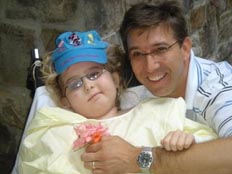
Photos and text used with permission of
Cord Schlobohm.
Enduring Strength and Love as a Legacy for a Little Girl
My daughter Sydney was a typical eight-year old girl. She loved school, soccer, music, playing with her
friends and sister.
It all happened very abruptly for her and our family. Over a weekend she developed some minor facial muscle
problems and balance issues. On Monday morning, my wife took Sydney to the pediatrician, and by that
evening I was at Children's Hospital in Washington, D.C., in a small conference room with my wife and the
neurologist caring for our daughter. The doctor informed us that Sydney had an aggressive type of brain
tumor. Due to the location and extent of the size of the tumor, there could be no surgery to remove it.
We were told her life expectancy was about six months, with little treatment available except some
radiation and clinical trial medications.
"Life gives you lemons and you make lemonade" was a saying I had often used. But this was an extreme test
for Sydney and for us as a family. We packed a lot of fun and love into those few remaining short months,
while still trying to live a "normal" life.
As a father or parent, it is just un-natural to have to bury your son or daughter.
Over time I wanted to make a difference, so that another father would not have to endure such a loss. I
became very involved in the Washington, D.C., Race for Hope, the largest fundraiser in the country for
brain tumor research. Shortly after, I joined the board of the National Brain Tumor Society. This is the
leading organization for brain tumor research, patient support services, and advocacy and awareness on
behalf of brain tumor patients.
I play a leading role in our advocacy efforts, partly due to the fact that I live near Washington. I was
honored to serve as a consumer reviewer for the Department of Defense Peer Reviewed Cancer Research Program.
Working alongside leading research scientists in pediatric brain tumors, I was able to provide some
perspective on the impact that a research grant could have on the lives of brain tumor patients and their
families. What I found most rewarding during the grant review process was how the scientists on the panel
really listened to my input as we rated the various grants. Although studying and reviewing the grants
required plenty of work, I felt extremely gratified that I could contribute to this process.
I extend my sincere gratitude to the Department of Defense for having this research program, one in which
researchers and patient advocates work together to help find a cure. There is a silver lining around every
dark cloud, and this program is a silver lining.
Last updated Thursday, May 26, 2022

















